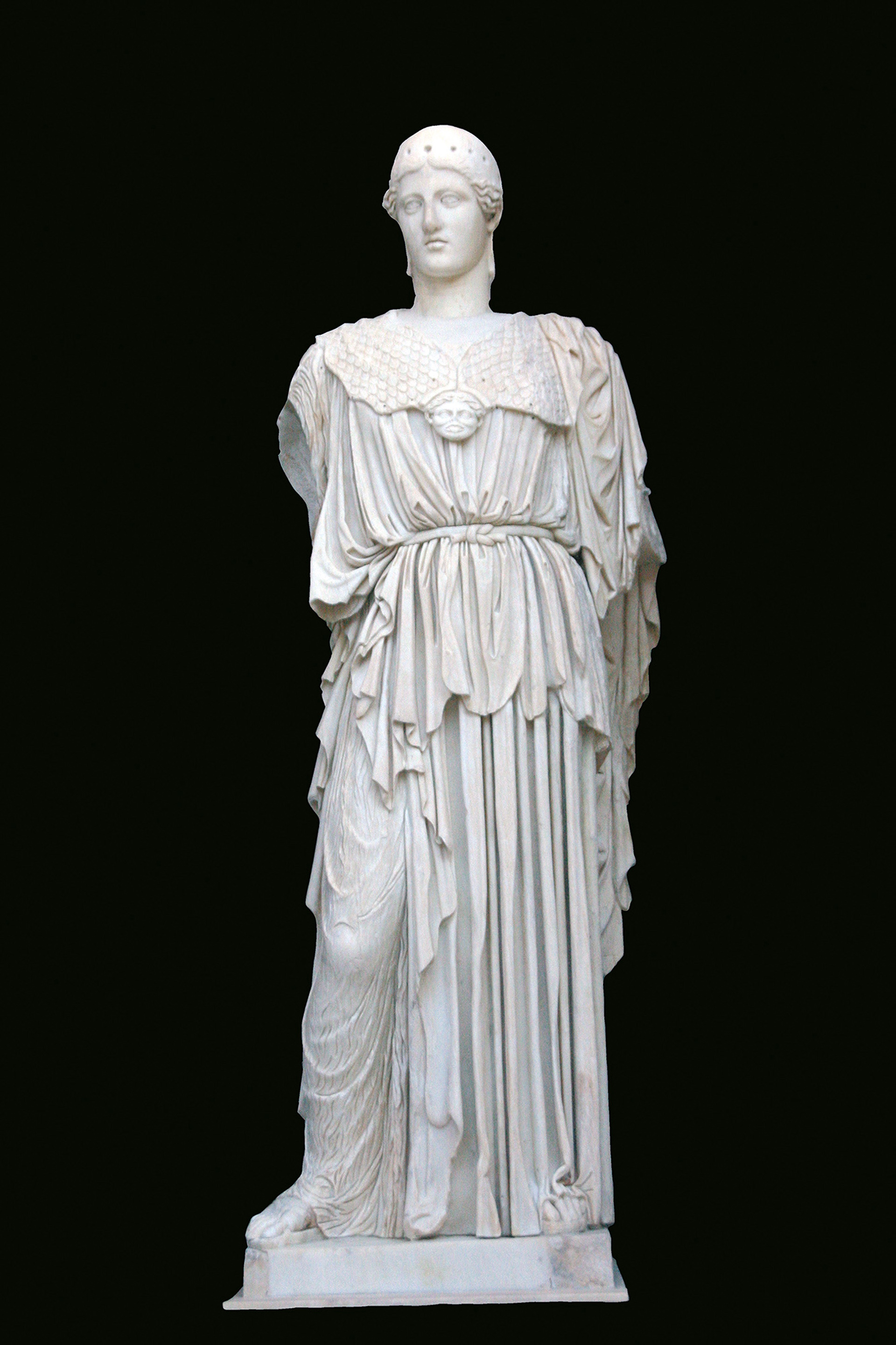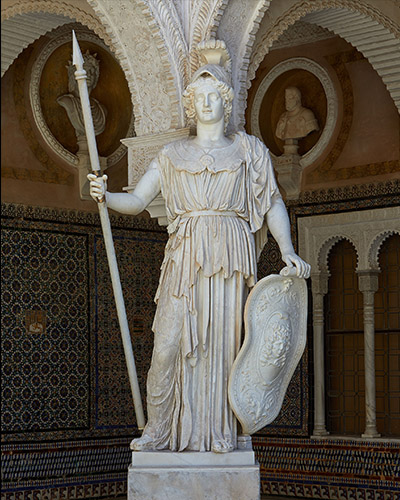"Welcome to the temple of the Muses!" With these words begins a chapter in the famed biography of Diego Velázquez written by the important art historian, Carl Justi. The scene is set in the "Patio Grande" of the Casa de Pilatos in Seville with "the four majestic marble goddesses in the corners". They appear as "fairies guarding the secrets of this miraculous fortress". One of them bears on the forehead of her plinth the inscription "Pallas Pacifera" - Athena the peacemaker - which may have been identical to the statue of Parthenope that presumably stood for centuries in front of the church of S. Stefano in Naples. Per Afán de Ribera, the first Duke of Alcalá, acquired the statue during his viceroyalty in Naples (1558-1571) and ordered its transport to Seville. Here it was installed as a pair with another statue of Athena which, according to its additions and an explanatory inscription, was interpreted as "Pallas belligera".
The 2.85 m high statue is missing both arms with their attributes and parts of the Attic helmet. Some of the toes of the right foot and the nose as well as both eyeballs have been added. The head, which belongs to the statue, was split into three parts and has been restored and placed on the torso. Overall: the state of preservation is outstanding.
The goddess is dressed in a chiton, a belted peplos and a mantle over her left shoulder. On the peplos she wears an aegis with the head of Medusa in the centre. The present statuary type is known from a multitude of Roman copies and named after a torso from the Medici collection in Rome (now in Paris, Musée du Louvre Inv. 3070). However, the "Pallas Pacifera" in the House of Pilate is the only copy of the "Athena Medici" that has survived together with its head. It is therefore the most complete version known to us. Despite many suggestions, the lost Greek original remains unidentified. However, it is undisputed that the original in question must be located in Athens and it is largely thought that the great Attic sculptor Phidias can be identified as the master. The German archaeologists Furtwängler, Lippold, Linfert and most recently Strocka are convinced that the sought-after original is the "Athena Promachos" from the Acropolis of Athens, a colossal bronze statue probably more than 10 metres high.
The copy of the House of Pilate is a work from Hadrian's time. Sculptures from Hadrian's Villa near Tivoli are comparable. Finds of plaster casts from Baiae, the site where the emperor died in 138 AD, attest to the quality of the highly detailed samples that served as models for the sculptors of this period. The Athena of the House of Pilate also came from one of the first-class sculpture workshops in Campania.
In antiquity, the gigantic statue of "Athena Promachos" in the Acropolis of Athens was visible from far away: ancient sources say that ships entering the port of Piraeus could recognise her radiant hull. Obviously she had spear and shield in her hands, her epithet "Promachos" - the paladin - appears only in late antique sources, but she was reputed to be an embodiment of fighting ability and combat readiness. Her material was bronze from the spoils of war in the fight against the Persians. We do not know if she was copied so many times for this reason in Roman times. It was rather because of its prominent place and its esteem as a tourist curiosity for the educated Romans. Hadrian in particular, who was born in Italica, was particularly fond of Athens and supported the city's urban development. The best copies of the idol from which we know the appearance of the bronze statue in Athens date back to the time of his rule. The original was probably transported to Constantinople where it irrevocably disappeared. This would explain the existence of a very good copy of the "Athena Promachos" in the vicinity of Naples because of the emperor's fondness for Greece in general and his particular love for Athens.
In 15th and 16th century Naples a statue of the goddess Athena would have enjoyed a special status, perhaps even being popularly identified with the famous "Athena Parthenos": the city was named "Parthenope" at the time of its foundation by Greek settlers, a fact of which its inhabitants were well aware. Per Afán de Ribera had the statue transported to Seville, where it has found its new home for almost half a millennium. In the 16th century, an oversized helmet was added to the statue, as well as a new shield and a huge mace. It may be an irony of fate that the warlike "Athena Promachos" of the Attic master Phidias was transformed in Seville into a symbol of the opposite: the "Pallas Pacifera". Two great sons of Seville were protagonists on their way from Athens to Seville: Hadrian and Per Afan de Ribera.
Bibliography:
M. Trunk, Die 'Casa de Pilatos' in Sevilla. Madrider Beiträge 28 (Mainz 2002).
C. Justi, Diego Velazquez und sein Jahrhundert (Leipzig 1933)
V. M. Strocka, Kopien nach Pheidias. Logische Stilentwicklung oder Circulus Vitiosus, in: Meisterwerke: Internationales Symposion Freiburg 2003 (München 2005) 121-142.
Markus Trunk, March 2009




